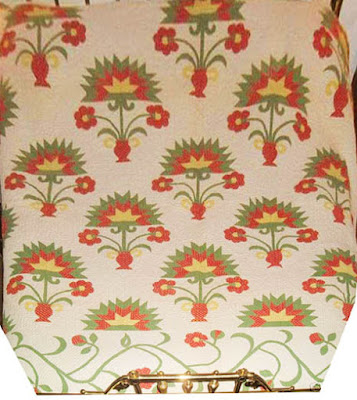Teri Klassen and I have been trading pictures of quilts in the Polk's Fancy design. This mid-19th- century top was from an Iowa family, she writes. The block is the regulation Polk's Fancy. The border is what Xenia Cord called a Vessel & Vine, something quite popular along the National Road which runs right through Indiana.
Sold at a Tennessee auction. Maybe a little later towards
the end of the century.
Online auction
Again, maybe later. The green???
Auction. 1880-1925? Applique quilts tended to get simpler after
1870. Fabrics less colorfast after 1880.
Ebay auction. Wide vine border.
Dealer John Sauls found this beauty in eastern Texas.
Montana's Museum of the Rockies owns a version with asymmetrical
borders.
Online auction. An unusual set, alternate blocks bordered with
sawtooth triangles.
Almost a twin to the one Ileana Villazon found
recently. Same alternate block idea but the triangles are different.
Spikier triangles. Fraternal twins.
Another online auction version but this one is missing its vase.
Relative from the International Quilt Museum's Dillow collection.
Then we get pretty far afield.
This has got to be easier than all those diamonds.
Close enough to count as example #22
So now we have 22 quilts in our Polk's Fancy file.
I couldn't resist drawing a pattern.
Cut an 18-1/2" square for background.
Sarah Childress and James K. Polk in the 1840s
From the Polk Home Museum in Columbia, Tennessee
See a post with information on the First Lady.
Jane Gracy Knox Polk (1776-1852)
James Polk died of cholera just three months after leaving the presidency, attended by his mother Jane Knox Polk who had a reputation for being a pious Presbyterian. During his term a friend from hometown Columbia, Tennessee wrote the President in 1846:
"I have just seen your mother at Mr. Frierson's quilting for the Missionary Society. She is very well."
Samuel Davies Frierson had once been Polk's law partner. His wife was Mary Mays Frierson, one of many quilting Friersons mentioned in county fair results. The Missionary Society was probably part of Zion Presbyterian Church in Maury County, which still stands.
Tomorrow: More digressions.






wFIYpIkg+YBSeVqTWmNQ~~60_57.jpg)

















No comments:
Post a Comment